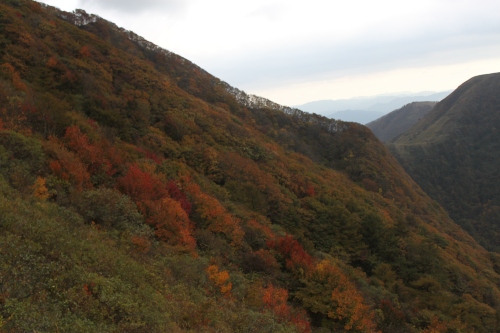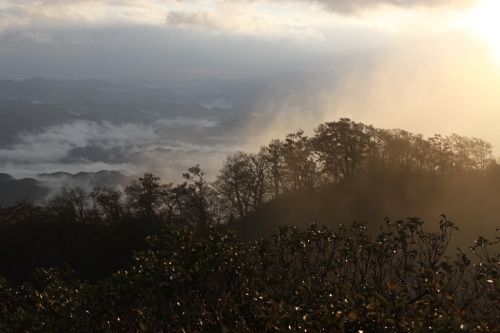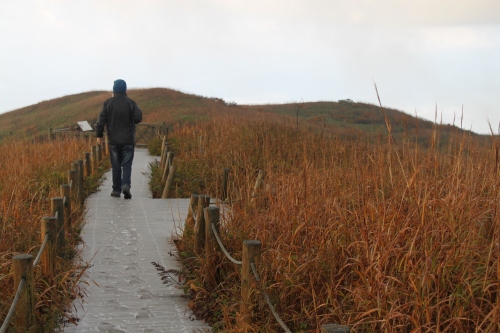Nestled snugly along the prefectural border of Okayama and Hyogo lies a formidable ridge of mountain peaks towering high over the secluded village of Chikusa. Known to Shugendō practitioners as the Nishi Ōmine, or Mt Ōmine of the west, the southern face of Mt Ushiro is home to the 13th century temple known as Dōsenji, whose inner sanctuary is still off-limits to women. Since there are two females in our quartet of hikers, we opt to skip this misogynistic nightmare and instead opt for the straightforward ascent of the southern face of Mt Funaki, followed by a half-hour stroll along the ridge to Mt Ushiro.

Paul pulls the car up to the small parking lot just opposite the idle campground. The trailhead is smothered with signposts in various states of decay, but from what we gather from the remaining bits of faded text, it is a 2km climb straight up the spur to the summit plateau, followed by a short descent to an unnamed saddle and a final climb up the western face. Paul, Mayumi, Maggie and I set off in single file, marching towards that summit ridge along a rocky promenade ablaze with autumn delights.

The path initially follows a small ravine along a narrow path marked consistently in red tape marks and signposts in much better condition than found below. One such way mark indicates we are trespassing along the Chūgoku Shuzen Hodō, a well-established network of paths penetrating the 5 prefectures of the Chūgoku region. All in all it covers a mind boggling distance of nearly 2300km and would be an immense undertaking for even seasoned walkers, though content as we are with this slither of a 2000 meter stretch of track.

Our route soon leaves the comforts of the valley floor and climbs abruptly through a glorious collection of hardwoods that have already started shedding their summer coats. By the time we reach the halfway point of the climb the trees are completely bare: a start contrast to the brilliant display of autumn hues just a few hundred vertical meters below.

After passing through a small grove of towering hardwoods, an upkept section of planted Hinoki cypress escorts us up the furthest reaches of the slopes to the start of the spur proper. This cypress follows us along the ridge that doubles as a property line. The forests to our right are owned by Dōsenji temple and retain their centuries-old charm, while to our left a thick wall of planted trees squeezes the life out of the forest. Many ridge lines in Japan retain this unique feature, and no greater a contrast can be found during the fall and winter season in this unsanctioned struggle between deciduous decrepitude and evergreen encroachment.

Our pleasant ascent in solitude is broken by the symphonic squalls of bear bells from the upper slopes ahead, as a battalion of elderly hikers descend toward us. Such groups two dozen strong are hardly a rare sighting in the mountains of Japan, as most visitors seem to visit the mountains to socialize rather than to seek spiritual solitude. We utter a quick greeting while letting them pass.

The spur soon intersects the summit ridge on the top of Mt Funaki sitting just 10 meters lower than Mt Ushiro at an altitude of 1334 meters. Funaki happens to feature on the list of Shisō 50 Meizan, or 50 peaks of the Shisō region of Hyōgo Prefecture. Fukada Kyūya’s greatest shortsight is in not trademarking the meizan name, for his estate would be quite wealthy with the plethora of ‘famous mountain’ lists permeating every region of Japan.

After a short break to catch our breath, we drop along a brilliant ridge of bamboo grass for the pleasant half an hour stroll to the summit of Okayama’s highest mountain. To be honest, it’s hard to call this peak part of the Chūgoku region as it lies in closer proximity to Kobe than Okayama. In fact, Mt Hinakura sitting directly opposite the valley is featured on the list of Kansai Hyakumeizan. But as I’ve told countless individuals before: “I didn’t choose the mountains – the mountains chose me”.

Paul brews up fresh coffee for everyone as we take in the warm autumn sunshine and stellar panoramic views. It’s hard to believe this is my final ‘Highest Prefectural Peak’ west of Fukui. There are still half a dozen more mountains to go, but I have faith that I can finish them off before I grow old and grey. As I look back over the preceding years, I consider myself lucky to have come this far, climbing mountains with faithful companions and escaping close calls with leaky valves and bleeding lungs.

We retrace our steps with the fading afternoon light as our accompaniment – it is these descents that I truly cherish in my mountain quests. With strong knees and, carried by the momentum of a successful ascent, I tend to shift into autopilot, but with the wilting light I walk spellbound, transfixed by the absolute beauty of the deciduous groves in their seasonal metamorphosis.











































